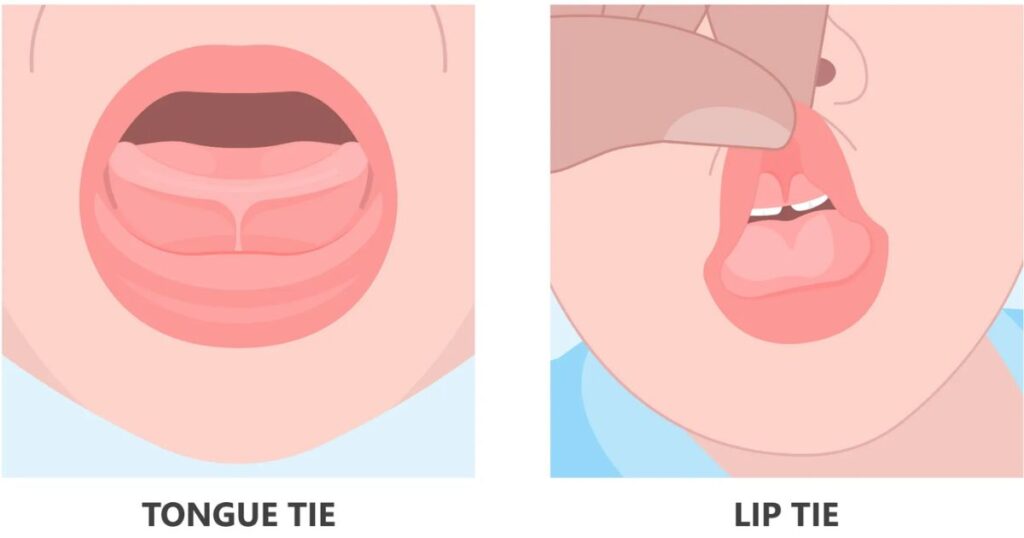Many parents experience challenges during their breastfeeding journey. One potential hurdle that can impact a baby’s ability to latch and feed effectively is a lip tie or tongue tie.
What are Lip and Tongue Ties?

- Lip Tie (ankyloglossia superior): This condition occurs when a small piece of tissue (frenulum) under the upper lip is unusually tight or short. This can restrict the lip’s upward movement, making it difficult for babies to flange (flare out) their lips for a good latch on the breast.
- Tongue Tie (ankyloglossia posterior): This happens when the frenulum underneath the tongue is too short or tight, limiting the tongue’s range of motion. A tongue tie can make it hard for babies to extend their tongue and reach the nipple effectively during breastfeeding.
It’s important to note that lip tie and tongue tie are relatively common. Studies estimate that around 4% to 10% of newborns have some degree of a lip or tongue tie. While not every case will require intervention, these conditions can sometimes lead to breastfeeding difficulties for both moms and babies.
Interesting Fact: Free Braces with Medicaid
5 Signs That Could Indicate Your Baby Has a Lip or Tongue Tie:
1. Difficulty Latching During Breastfeeding
- A baby with a lip or tongue tie may struggle to latch deeply onto the breast. This can result in a shallow latch where only the nipple is taken in, not the entire areola.
- Look for signs like short sucking bursts, clicking sounds while feeding, and the baby’s tongue seeming cupped or tucked under during nursing attempts.
2. Painful Breastfeeding
- Restricted movement due to a lip or tongue tie can make it hard for babies to effective transfer milk. This can lead to frustration and nipple pain for mothers.
- You might experience cracked or damaged nipples due to constant shallow latching and friction.
3. Infant Fatigue While Breastfeeding
- Ineffective sucking due to a tie can leave babies tired and frustrated during feeding sessions.
- Signs include frequent fussiness at the breast, falling asleep quickly during feeds, and not seeming satisfied after nursing.
4. Poor Weight Gain
- Difficulties with breastfeeding due to a lip or tongue tie can sometimes impact a baby’s weight gain, especially in newborns.
- Consistent weight gain monitoring by a pediatrician is crucial during the early weeks and months.
5. Limited Tongue Mobility
- In some cases, a severe tongue tie might restrict a baby’s ability to stick out their tongue or move it side-to-side.
- While this may not directly impact breastfeeding, some parents worry about the potential connection to future speech development (which we’ll address later).
It’s important to remember that these signs can also be caused by other factors. If you suspect your baby has a lip or tongue tie, consult with a lactation consultant or pediatrician for a proper diagnosis.
Next Steps After Identifying a Lip or Tongue Tie:

Early diagnosis and intervention are key for addressing lip and tongue ties in babies. A healthcare professional can assess the severity of the tie and recommend the best course of action.
Here are some possibilities:
- Lip Tie and Tongue Tie Exercises: In some mild cases, healthcare professionals might recommend exercises to improve lip and tongue mobility. These exercises are typically done by parents several times a day and can help stretch the frenulum.
- Lip Tie and Tongue Tie Surgery (Frenotomy or Frenulectomy): For more pronounced ties that significantly impact breastfeeding, a frenotomy or frenulectomy might be recommended. This is a minor surgical procedure performed by a qualified healthcare provider to release the lip or tongue tie. It’s typically quick, minimally invasive, and done with a laser or small surgical instrument.
- Lip Tie and Tongue Tie Revision: In rare cases, a revision surgery might be necessary if the initial procedure wasn’t fully effective.
Additional Information About Lip and Tongue Ties
Lip and Tongue Tie Symptoms in Adults
It’s important to know that lip and tongue ties can sometimes go undiagnosed in infancy and persist into adulthood. While less common, adults with undiagnosed ties might experience symptoms like speech difficulties, trouble chewing or swallowing certain foods, or even chronic neck or jaw pain.
Lip Tie and Tongue Tie Speech Problems
Severe tongue ties can impact speech development in children. But, early diagnosis and treatment of ties can help prevent future speech problems. If you have concerns about your child’s speech development, consult with a speech therapist or pediatrician.
Lip Tie and Tongue Tie Pain
Lip ties can contribute to pain in the upper lip or frenulum area in some adults. This can be especially bothersome during activities that need a lot of lip movement, like playing a wind.
Case Study: Sarah’s Experience with Her Baby’s Tongue Tie
Sarah, a first-time mom, noticed her newborn, Liam, seemed to struggle during breastfeeding sessions. Liam would latch on for a short while, but then become fussy and frustrated. Sarah’s nipples were becoming sore, and Liam wasn’t gaining weight as expected.
Concerned about these issues, Sarah reached out to her pediatrician. After examining Liam, the pediatrician suspected a tongue tie might be contributing to the difficulties. A referral to a lactation consultant confirmed the diagnosis. The lactation consultant determined that Liam’s tongue tie was mild and recommended a combination of breastfeeding exercises and a frenotomy procedure.
Following the frenotomy, Liam’s latch improved significantly. He could now nurse more effectively and transferred milk efficiently. Sarah’s nipple pain subsided, and Liam began gaining weight steadily.
Lip Tie vs. Tongue Tie: Understanding the Differences
While both lip and tongue ties can affect breastfeeding, they present slightly different challenges. Here’s a quick breakdown:
| Feature | Lip Tie | Tongue Tie |
| Restricted Movement | Upper lip movement | Tongue range of motion |
| Impact on Latch | Affects ability to flange (flare) lips | Limits ability to extend tongue and reach nipple |
| Potential Symptoms | Shallow latch, clicking sounds | Short sucking bursts, cupped tongue |
Treatment Considerations
The course of treatment for a lip or tongue tie will depend on the severity of the condition and its impact on breastfeeding. Here’s a general overview:
- Mild Ties: For mild lip or tongue ties, exercises or frenotomy with minimal tissue release might be sufficient.
- Severe Ties: In severe cases, a more extensive frenotomy or frenulectomy might be needed to ensure proper tongue or lip mobility.
Also Read: Is Black a Good Color for Braces?
FAQ’s
How do I know if my tongue tie is affecting my breastfeeding?”
If you’re experiencing difficulties with breastfeeding, such as pain or poor latch, and your baby has trouble maintaining suction, it could be a sign that tongue tie is affecting breastfeeding.
How do I know if my baby has a lip tie or tongue tie?”
Look for symptoms like difficulty latching, clicking noises while feeding, poor weight gain, or a heart-shaped or tight upper lip frenulum to determine if your baby may have a lip tie or tongue tie.
What does lip tie latch look like?”
A lip tie latch may appear shallow or ineffective,
The Bottom Line
Lip and tongue ties are treatable conditions. If you suspect your baby has a tie, don’t hesitate to consult with a healthcare professional for a proper diagnosis. Early intervention can significantly improve breastfeeding success and ensure your baby receives the essential nutrients for healthy growth and development.








